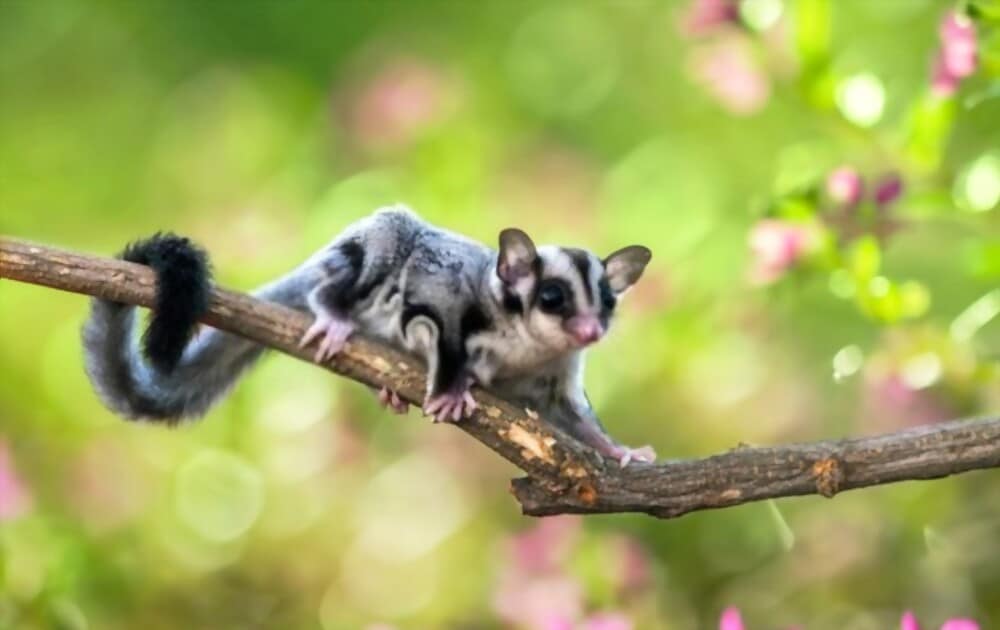Sugar gliders, the adorable small marsupials, have a varied diet that includes fruits and vegetables. One such vegetable that sugar gliders can enjoy is zucchini.
Zucchini is not only safe for sugar gliders to eat but also provides them with essential nutrients. It is low in calories and high in water content, making it a healthy snack option for these gliders.
However, it is important to remember that zucchini should be given in moderation as part of a balanced diet. Too much zucchini can cause digestive issues for sugar gliders.

Always consult with a veterinarian or a sugar glider expert to ensure you are providing the right amount and variety of food for your furry friend.
Incorporating Zucchini into Sugar Gliders’ Diet
When it comes to the diet of sugar gliders, it is important to provide them with a balanced and nutritious meal. One vegetable that can be incorporated into their diet is zucchini. Zucchini is a versatile and healthy vegetable that can offer several benefits to sugar gliders. In this section, we will explore the reasons why zucchini is a great addition to their diet and how to incorporate it effectively.

Benefits of Zucchini for Sugar Gliders
Zucchini is a low-calorie vegetable that is packed with essential vitamins and minerals. Here are some of the benefits it offers to sugar gliders:
- Nutrient-rich: Zucchini is rich in vitamins A, C, and K, as well as potassium, magnesium, and fiber. These nutrients are crucial for the overall health and well-being of sugar gliders.
- Hydration: Zucchini has a high water content, which helps keep sugar gliders hydrated, especially during hot weather.
- Digestive health: The fiber content in zucchini promotes healthy digestion in sugar gliders, preventing constipation and bloating.
- Weight management: Due to its low-calorie nature, zucchini can be a beneficial addition to the diet of sugar gliders who need to maintain a healthy weight.
Incorporating Zucchini into the Diet
When introducing zucchini to the diet of sugar gliders, it is important to do so gradually to avoid digestive upset. Here are some tips on how to incorporate zucchini effectively:
- Preparing the zucchini: Wash the zucchini thoroughly and remove the skin. Cut it into small, bite-sized pieces that are easy for sugar gliders to consume.
- Mixing with other foods: Zucchini can be mixed with other fruits and vegetables that sugar gliders already enjoy. This can help to introduce the new food while still providing familiar flavors.
- Offering as a treat: Zucchini can be offered as a treat or snack for sugar gliders. This can be a great way to provide variety in their diet and keep them mentally stimulated.
- Varying the preparation methods: Zucchini can be served raw or cooked. Some sugar gliders may prefer one over the other, so it’s worth trying both to see which they prefer.
Cautionary Notes
While zucchini can be a healthy addition to the diet of sugar gliders, it is important to keep a few things in mind:
- Portion control: Like any other food, zucchini should be offered in moderation. Too much zucchini can upset the balance of their diet and lead to nutritional imbalances.
- Allergies or sensitivities: It is important to observe sugar gliders for any signs of allergies or sensitivities to zucchini. If any adverse reactions occur, discontinue feeding it immediately and consult a veterinarian.
- Organic and pesticide-free: Whenever possible, choose organic zucchini to avoid exposing sugar gliders to harmful pesticides.
In summary, zucchini can be a beneficial addition to the diet of sugar gliders. Its nutrient content, hydration properties, and digestive benefits make it a healthy choice. By gradually introducing zucchini and considering the preferences and sensitivities of individual sugar gliders, you can incorporate this versatile vegetable into their diet effectively.

Potential Risks of Feeding Zucchini to Sugar Gliders
Zucchini is a nutritious and delicious vegetable that humans often enjoy as part of a healthy diet. However, when it comes to feeding zucchini to sugar gliders, there are a few potential risks that should be considered. While zucchini can be a safe treat for these small marsupials, it is essential to understand the potential risks and take precautions to ensure the well-being of your sugar gliders.
Risk of Gastrointestinal Issues
One of the main risks associated with feeding zucchini to sugar gliders is the potential for gastrointestinal issues. Sugar gliders have delicate digestive systems and may struggle to digest certain types of food. Zucchini contains a high amount of water and fiber, which can lead to diarrhea or upset stomachs in sugar gliders if given in excessive amounts.
To mitigate this risk, it is crucial to feed zucchini to sugar gliders in moderation. Offer small, bite-sized pieces of zucchini as an occasional treat rather than making it a staple in their diet. Additionally, always monitor their feces for any signs of digestive issues and consult a veterinarian if you notice any abnormal changes.
Pesticide Contamination
Another potential risk when feeding zucchini to sugar gliders is the presence of pesticide residue. Conventionally grown zucchinis may be treated with pesticides, which can be harmful to sugar gliders if ingested. These chemicals can negatively impact their health and overall well-being.
It is recommended to choose organic zucchinis whenever possible to minimize the risk of pesticide contamination. Organic produce is grown without the use of synthetic pesticides, making it a safer option for your sugar gliders. Alternatively, you can wash and peel conventionally grown zucchinis to reduce pesticide exposure.
Choking Hazard
While zucchini is generally soft and easy to chew, there is still a risk of choking, especially if the zucchini is not prepared appropriately. Sugar gliders have small mouths, and large chunks of zucchini can pose a choking hazard. Always ensure that the zucchini is cut into small, manageable pieces before offering it to your sugar gliders.
By cutting the zucchini into small, bite-sized portions, you can reduce the risk of choking and make it easier for your sugar gliders to consume. It is also important to supervise them while eating to ensure they are not experiencing any difficulties.
Feeding zucchini to sugar gliders can be a nutritious and enjoyable treat for them, but it is essential to be aware of the potential risks involved. To prevent gastrointestinal issues, offer zucchini in moderation and monitor their digestion. Choose organic zucchinis or wash and peel conventionally grown ones to minimize pesticide exposure. Lastly, always cut the zucchini into small pieces to prevent choking. By taking these precautions, you can safely incorporate zucchini into your sugar glider’s diet and provide them with a varied and nutritious menu.
Alternatives to Zucchini for Sugar Gliders’ Dietary Variety
Sugar gliders, small and adorable marsupials, require a varied diet to ensure their overall health and well-being. A significant part of their diet includes fruits and vegetables, which provide essential vitamins and minerals. While zucchini is commonly included in a sugar glider’s diet, it’s important to introduce variety to their meals for optimal nutrition and to prevent boredom. In this section, we will explore some alternatives to zucchini that can be incorporated into a sugar glider’s diet.
1. Sweet Potato
Sweet potatoes are an excellent alternative to zucchini for sugar gliders. These root vegetables are rich in vitamins A and C, dietary fiber, and antioxidants. They also offer a natural sweetness that sugar gliders find appealing. You can prepare sweet potatoes by baking or steaming them and then mashing them into a soft consistency suitable for your glider to consume.
2. Bell Peppers
Bell peppers are another great addition to a sugar glider’s diet. They are packed with vitamin C and other beneficial nutrients. The vibrant colors of bell peppers make them visually appealing to sugar gliders, and the crunchy texture adds a delightful variety to their meals. You can offer small, bite-sized pieces of bell peppers to your glider as a healthy treat.
3. Carrots
Carrots are a popular and readily available vegetable that can be an excellent substitute for zucchini. They are high in vitamin A and fiber, promoting good eye health and aiding digestion. You can offer carrot sticks or grated carrots to your sugar glider, providing them with a crunchy and nutritious snack.
4. Cucumber
Cucumbers are a refreshing and hydrating vegetable that can be a great addition to your sugar glider’s diet. They contain high water content and are low in calories, making them an ideal option for gliders on a weight management plan. Additionally, cucumbers provide vitamins K and C. Slice cucumbers into small pieces and offer them to your glider as a hydrating treat.
5. Butternut Squash
Butternut squash is a nutritious alternative to zucchini that sugar gliders can enjoy. It is rich in complex carbohydrates, vitamins A and C, and dietary fiber. You can cook butternut squash by baking or steaming it until it becomes soft and tender. Once cooked, mash it into a suitable consistency for your glider to consume.
6. Broccoli
Broccoli is a vegetable that provides numerous health benefits to sugar gliders. It is packed with vitamins C and K, dietary fiber, and antioxidants. The crunchy texture of broccoli can be a fun addition to your glider’s meals. Make sure to cut the broccoli florets into small, bite-sized pieces for easy consumption.
7. Papaya
Papaya is a tropical fruit that can be a delightful addition to a sugar glider’s diet. It is a rich source of vitamins A and C, as well as digestive enzymes that aid in proper digestion. Offer small, ripe pieces of papaya to your glider as a sweet and nutritious treat.
It’s important to remember that any new food introduced to your sugar glider should be done gradually and in moderation. Always observe your glider’s reaction to new foods and consult with a veterinarian if you have any concerns. By incorporating a variety of fruits and vegetables into your sugar glider’s diet, you can ensure they receive a well-rounded and nutritionally balanced meal.
Can sugar gliders eat zucchini?
Yes, sugar gliders can eat zucchini. It is a safe and healthy vegetable for them to consume. However, it should be given in moderation as part of a balanced diet alongside other fruits, vegetables, and protein sources.
Conclusion
In conclusion, sugar gliders can indeed eat zucchini as part of their diet. Zucchini is a nutritious vegetable that provides necessary vitamins and minerals for their overall health. It can be served raw or cooked, but it is important to ensure that the zucchini is thoroughly washed and cut into small, manageable pieces for easy consumption by these small marsupials. However, zucchini should be offered in moderation as a treat, rather than a staple food, as sugar gliders require a diverse diet that includes a variety of fruits, vegetables, and protein sources to meet their nutritional needs.
By incorporating zucchini into their diet, sugar gliders can enjoy the benefits of this vegetable’s high water content and essential nutrients, adding variety to their meals while promoting their overall well-being.

